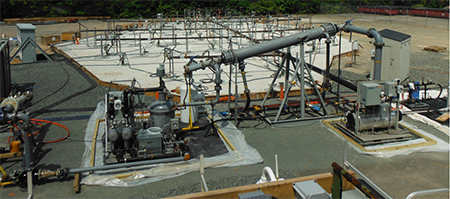SITE BACKGROUND
From 1947 to the early 1970s, the former facility formulated paints, coal-tar enamel, and related coal-tar products. In the early 1970s, coal tar epoxy and other tar coatings were added to the product line. Raw materials used in the formulation process included coal-tar pitch, coal-tar solvent, creosote, xylene, and methanol. Finished products were transported off-site for distribution. Tetrachloroethylene (PCE) was reportedly stored on site and was used in various plant manufacturing processes and equipment cleaning efforts.
GEOLOGY AND HYDROGEOLOGY
The site is paved, mostly with a concrete surface, underlain by a stratigraphic sequence consisting of an overburden layer of fill deposits and glacial till, which in turn, overlies weathered bedrock and competent bedrock. The overburden consists of a 1 to 3 foot layer of fill material that overlies a glacial till (the Rahway Till). The glacial till is generally comprised of a matrix of clay and/or silt with discontinuous sand lenses and sand horizons with little to some gravel and boulders within the clayey silt matrix. The soil is silty clay and has low moisture content (<10%), high density (140 pounds per cubic foot), and low permeability.
CHALLENGES & SOLUTIONS
TerraTherm chose to treat this facility via TCH. The challenge that our team encountered was that the rate of heat up in the shallow soils was not meeting the modeled expectations. The heat up rate was meeting and even exceeding the modeled rate in the middle and deeper zones. By strategically valving back and in some cases, closing completely, the co-located vacuum extraction wells in the problem areas, we were able to resolve this issue.
RESULTS
The project was completed successfully, on schedule and within budget. The results were 03 mg/kg PCE and 16 mg/kg naphthalene.
